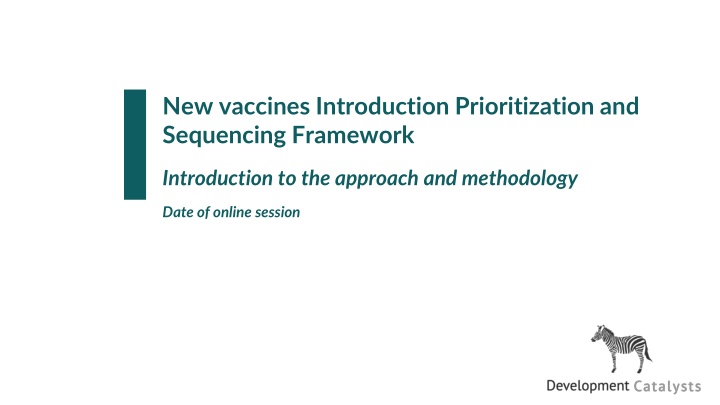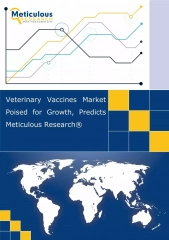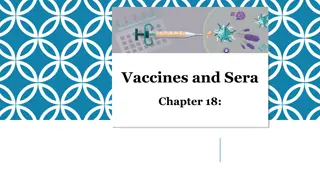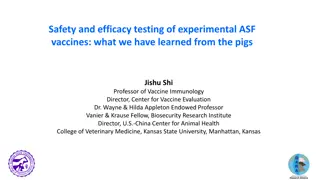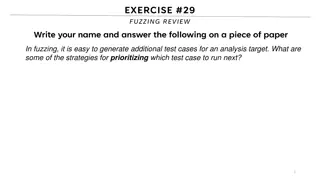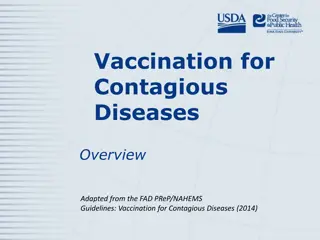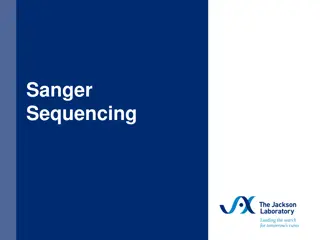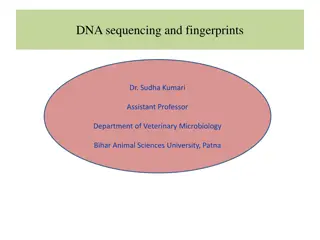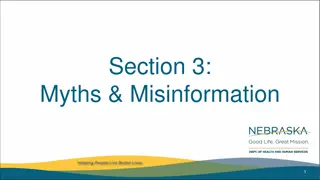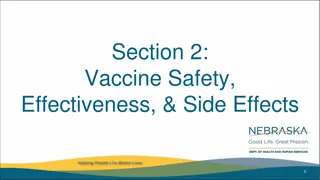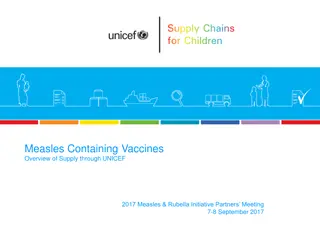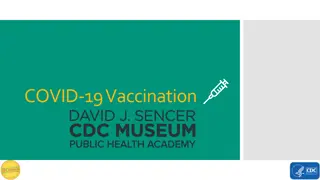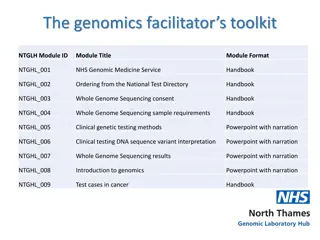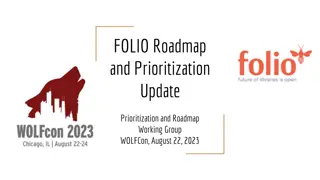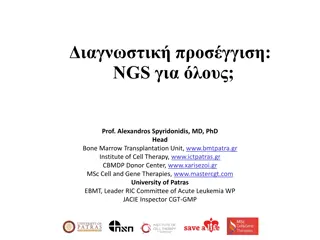New vaccines Introduction Prioritization and Sequencing Framework
Countries face challenges in introducing multiple vaccines, leading to overwhelmed immunization programs. The NVI Prioritization Framework helps NITAGs prioritize new vaccines effectively to address risks and ensure sustainable delivery. The framework utilizes evidence-based criteria and comprehensive methodology to develop sequencing recommendations. Objectives involve reviewing the framework methodology, discussing processes, defining criteria, and gathering feedback through an online questionnaire.
Download Presentation

Please find below an Image/Link to download the presentation.
The content on the website is provided AS IS for your information and personal use only. It may not be sold, licensed, or shared on other websites without obtaining consent from the author.If you encounter any issues during the download, it is possible that the publisher has removed the file from their server.
You are allowed to download the files provided on this website for personal or commercial use, subject to the condition that they are used lawfully. All files are the property of their respective owners.
The content on the website is provided AS IS for your information and personal use only. It may not be sold, licensed, or shared on other websites without obtaining consent from the author.
E N D
Presentation Transcript
New vaccines Introduction Prioritization and Sequencing Framework Introduction to the approach and methodology Date of online session
Agenda To be updated by country Time Activity Responsible 15 minutes Introductions and Objectives TBD 30 minutes Approach and methodology TBD 45 minutes Criteria TBD 15 minutes Workplan TBD 15 minutes Online questionnaire TBD 2
Agenda Introductions and Objectives 1 Approach and Methodology 2 Workplan 3 Prioritization Criteria 4 Online Questionnaire 5
Context: Countries are pushed to introduce more and more vaccines, potentially resulting in the entire EPI being overwhelmed and unable to deliver Countries & NITAGs are facing increased pressure to introduce new vaccines and NVI recommendations are often siloed resulting in the adoption of ambitious new vaccine introduction roadmaps built without an adequate process which bears risks on the immunization programs Example Political agenda Absence of financial sustainability Vaccine Disease Year Inability for the program to deliver RTS, S/AS 01 Malaria 2024 Donors agenda RR Measles & Rubella 2024 Rotarix Rotavirus 2024/2025 Competition for resources between vaccine programs Recommendations from experts R21-Matrix-M Malaria 2024/2025 Gardasil HPV 2026 Shanchol/Euvichol Cholera 2026 Public and media pressure Competition for resources with other health programmes HepB Hepatitis B 2027 TCV Typhoid 2028 Regional & neighboring countries expectations Lower acceptability & demand 4
The NITAG will adapt and apply the NVI Prioritization Framework to prioritize new vaccine introductions and produce sequencing recommendations The NVI Prioritization Framework is a proven NITAG-driven framework supporting the prioritization of new vaccine introductions. It leverages a simple, evidence-based and comprehensive approach to support the preparation of NVI sequencing scenarios based on a pre-hierarchized list of potential criteria. It was developed in alignment with existing tools (VIS, EtR) to ensure the consistency of the process 1. 2. 3. 4. Review the NVI Prioritization Framework methodology Discuss the expected process and timeline Review the comprehensive criteria list Distribute online questionnaire to inform critical decision points for adapting the framework Today s objectives 5
Agenda Introductions and Objectives 1 Approach and Methodology 2 Workplan 3 Prioritization Criteria 4 Online Questionnaire 5
The NVI Prioritization Framework has been built to be evidence-based, simple yet comprehensive, iterative and to allow for tweaks based on countries own priorities Decisions on sequencing are often influenced by national and international agenda and rely on opinions rather than facts This framework relies on measurable evidence to ensure consistency of decision-making through time Evidence-based Existing tools and processes either refer to overabundant criteria or to no criteria at all This framework refers to a limited number of criteria which will be selected by the NITAG The selected criteria should allow the NITAG to answer simple but crucial questions. Simple Decisions regarding vaccine introductions are often taken independently and with different processes based on the nature of the decision This framework is designed to be comprehensive in terms of vaccines and type of country Comprehensive To allow for better appropriation by countries, the prioritization framework will be discussed and adapted by the NITAG, which will be done mainly through the addition or removal of secondary criteria and the selection of candidate vaccines Adaptative Current decision-making on NVI sequencing is done on a reactive basis, often to answer requests from technical partners or submit grant applications to donors This exercise can be conducted by the NITAGs on a recurring basis to ensure adaptation to evolving research and markets Iterative 7 Sources: discussions with WHO/GAVI, Capaciti manual
The vaccine introduction prioritization funnel relies on a series of assessments and decisions based on a sub-set of pre-selected criteria Framework Implementation Process Phase 3: Phase 1: Framework Adaptation Phase 2: Assessment, Prioritization and Sequencing Recommendations Selected vaccines Candidate vaccines Scenarii of NVI sequence Prioritized vaccines High Priority vaccines Importance 202X 202Y 202Z 202A Scenario I 202X 202Y 202Z 202A Scenario II Medium Priority vaccines Feasibility BURDEN OF INTRODUCTION PRESELECTION IMPORTANCE & FEASIBILITY Which vaccines are the most important to introduce? Which vaccines are the easiest to introduce? What programmatic constraints and other uncertainties must be considered for introduction? Which vaccines should be considered for introduction? Main questions
The NITAG will adapt and apply the NVI Prioritization Framework to produce evidence-based prioritization and sequencing recommendations to be disseminated to the authorities. Phase 2: Assessment, Prioritization and Sequencing 3 months Phase 3: Recommendations 2 months Phase 1: Framework Adaptation 1 month Process design and stakeholder engagement Validation and documentation Workshop 1 Workshop 2 Data collection Objectives: Objectives: Objectives: Develop workplan and timeline Collect and assess available data Document actionable recommendations Endorsement by Ministry of Health and integration into national program Engage key stakeholders Translate evidence into prioritizations using vaccine ranking Ensure consensus and consistency Define list of vaccines and the timeframe to be considered Explore programmatic constraints Develop final recommendation materials Select criteria for decision-making Develop sequencing recommendations Plan for data collection Output: Output: Output: Prioritized and weighted criteria for decision-making Prioritized vaccine lists for introduction (high and medium priority) Finalized recommendation shared with EPI and Ministry of Health Preselection of vaccines to consider for introduction Scenarii for sequencing based on known constraints Workplan to collect and prepare data for assessment
Agenda Introductions and Objectives 1 Approach and Methodology 2 Workplan 3 Prioritization Criteria 4 Online Questionnaire 5
NVI Prioritization Workplan To be updated Month by country Month Month Month Month Month Activities Lead / Support Week Week Week Week Week Week Week Week Week Week Week Week Week Week Week Week Week Week Week Week Week Week Week Week Week Phases Methodology Review Validation Workshops Date ToR & Budgeting Logistics Agenda & invite Documents Facilitation Data Retrieval Iterations Analysis / presentation Recommandations Finalization Review with EPI ICC NIS integration Phase I Phase II Phase III Workshop 1 Workshop 2 Online session (today) 11
Agenda Introductions and Objectives 1 Approach and Methodology 2 Workplan 3 Prioritization Criteria 4 Online Questionnaire 5
An extensive literature review was carried out to create a comprehensive list of criteria Title Year Author(s) An analytical framework for immunization programs in Canada 2004 L.J. Erickson, P. De Wals, L. Farand National decision-making on adopting new vaccines: a systematic review 2011 Burchett et al. New vaccine adoption: qualitative study of national decision-making processes in seven low- and middle-income countries 2012 Burchett et al. Ranking Vaccines: A Prioritization Framework: Phase I: Demonstration of Concept and a Software Blueprint 2012 Guruprasad Madhavan, Kinpritma Sangha, Charles Phelps, Dennis Fryback, Tracy Lieu, Rose Marie Martinez, and Lonnie King SAGE Guidance for the development of evidence-based vaccination- related recommendations 2017 WHO National decision-making for the introduction of new vaccines: A systematic review, 2010 2020 2021 Morgane Donadel, Maria Susana Panero, Lynnette Ametewee, Abigail M. Shefer Factors influencing the prioritization of vaccines by policymakers in low- and middle-income countries: a scoping review 2022 Guillaume et al. The Use of Multicriteria Decision Analysis to Support Decision Making in Healthcare: An Updated Systematic Literature Review 2023 Pamela Gongora-Salazar, MSc, Stephen Rocks, MSc, Patrick Fahr, DPhil, Oliver Rivero-Arias, DPhil CAPACITI Tool & Manual WHO Vaccine Investment Strategy (VIS) process GAVI
These criteria relate to 10 topics and are categorized based on the prioritization stage Prioritization stage Disease and vaccine External factors Program factors Burden & Market availability Strategy Importance epidemiology of the disease Finances & economics Logistics Feasibility Benefits of the vaccine Legal & ethical Service delivery Vaccine safety Acceptability of the vaccine 14
71 criteria have been identified Criterion Ethical, programmatic, reputational or social issues that may affect acceptability of the vaccine to the target population (e.g. reputation of the country producer, halal) Level of use in HICs, thought-leader or neighbouring countries (e.g. related to safety) Perception of the target population of the disease risk, severity, fear and demand for disease control Perception of the target population on the desirable and undesirable effects of the vaccine Acceptability of schedule (e.g. multiple injections, additional visits) Category Acceptability of the vaccine Sud-category Perception of target population of the vaccine Criterion Net present cost benefit ratios (from health care and societal perspectives) of vaccine vs. alternative strategies (per life saved, case prevented, life year gained, quality-adjusted life year gained) Absence of legal constraints concerning use of vaccine (i.e. departure from manufacturers recommendations/off license use of the vaccine, mandatory, recording, potential compensation for adverse events, incentives) Licensing by foreign NRA Prequalified by WHO Licensing by national RA Accessibility and equity of vaccination for the target population Ethical, market and diplomatic issues that may affect acceptability of the vaccine to stakeholders Compatibility of the presentation of the vaccines with the expected uses in the country (e.g. to population spread in the country) Ease of conservation (volume & cold chain requirements) Shelf life of the vaccine Availability of adequate cold chain equipment at all levels or ability to procure CCE required to store the vaccine Readiness of the existing distribution channels in the country Indicative wastage rate Ability to maintain wastage at expected levels Ability to manage waste Adequacy of the labels to the local language Market availability of the vaccine and supplies over the selected time period Sustainability of the market availability of the vaccine and supplies in the longer term Ease of procurement of the vaccine Safety issues related to the product being similar to an existing vaccines or drugs Risk at population level (e.g. risk of displacement of average age of infection, potential impact of strain selection or emergence of non-vaccine serotypes) Risk at individual level incl. Type, severity, consequences and frequency of AEFI, including reactogenicity profile & capacity to mitigate known adverse events Contraindications and precautions for vaccination (e.g. requirement to check background especially factoring risk groups or risk factors) Interference with other vaccines regarding immunity/protection Ease of preparation, reconstitution & administration (open-vial policy, CTC) Expected impact of the introduction on the human resources Impact on existing immunization services or other health sectors - risk of overload Availability of information systems to manage the vaccine supply chain and measure related performance metrics (i.e. coverage and vaccine utilization) Interchangeability with alternative or future products/presentations Contribution to national/regional/global goals (e.g., eradication, control, elimination, reduction) Opportunity to pair introduction with other planned program (e.g. other vaccine introduction or switch with same target population) Existing recommendations / guidelines for use (e.g. SAGE, professional organizations) Accessibility of the target population (age, gender, special risk) Ease of the considered immunization strategies - incl. geographic (stepwise or nationwide) and target populations (selective/stepwise or universal) Administration strategy (single dose, routine primary series only, booster, campaigns) Feasibility of the program delivery strategy (physicians, CHW, nurses, pharmacists, school-based) Category Finances & economics Sub-category Ratio Acceptability of the vaccine Perception of target population of the vaccine Perception of target population of the disease Perception of target population of the vaccine Perception of target population of the vaccine Demand generation Direct impact Direct impact Legal & Ethical Legal Acceptability of the vaccine Legal & Ethical Legal & Ethical Legal & Ethical Legal & Ethical Legal & Ethical Legal Legal Legal Ethical Ethical Acceptability of the vaccine Acceptability of the vaccine Availability of resources for marketing and communication Coverage of active serogroups or serotypes in the country Effectiveness of the vaccine including in different populations/age groups/cohorts Efficacy and immunogenicity of the vaccine in target population Duration of protection and waning of immunity Number needed to vaccinate to prevent a case Impact on resistance to antibiotics & antivirals Herd immunity / protection Effect of the vaccine on transmission Cost of the disease to the health system Direct & indirect costs to patient & families Short- and long-term use of health care (e.g. treatments, hospitalization) Productivity losses e.g. linked to work & school absenteeism linked to the disease Burden inequity Incidence including in different sociodemographic and age groups Prevalence including in different sociodemographic and age groups Outbreak potential incl. past occurrence of outbreaks and potential for international spread, and epidemic and pandemic risk Hospitalization rate Mortality and lethality incl. in different sociodemographic and age groups Intensity of suffering/severity of disease symptoms Long-term complications of disease Disability-adjusted life years (DALYs) Loss of quality-adjusted life years (QALYs) Absence of satisfactory alternatives to prevent/treat the disease Acceptability of the vaccine Benefits of the vaccine Benefits of the vaccine Logistics Product aspect Logistics Logistics Logistics Cold Chain Cold Chain Cold Chain Benefits of the vaccine Benefits of the vaccine Benefits of the vaccine Benefits of the vaccine Benefits of the vaccine Benefits of the vaccine Burden & epidemiology Burden & epidemiology Burden & epidemiology Direct impact Direct impact Direct impact Indirect impact Indirect impact Indirect impact Economic impact Economic impact Economic impact Logistics Logistics Logistics Logistics Logistics Market availability Market availability Market availability Vaccine safety Vaccine safety Distribution Wastage Wastage Wastage Product aspect Availability Availability Procurement Safety Safety Burden & epidemiology Economic impact Burden & epidemiology Burden & epidemiology Burden & epidemiology Burden & epidemiology Epidemiology Epidemiology Epidemiology Epidemiology Vaccine safety Safety Vaccine safety Safety Burden & epidemiology Burden & epidemiology Health impact Health impact Vaccine safety Service delivery Service delivery Service delivery Service delivery Safety Human Resources Human Resources Human Resources Systems Burden & epidemiology Burden & epidemiology Burden & epidemiology Burden & epidemiology Burden & epidemiology Social impact Social impact Social impact Social impact Alternatives Strategy Strategy Opportunities Opportunities Social and economic benefits including reduction in health care costs, improvement in life expectancy, in quality of life for individuals, families, caregivers and communities, productivity gains Indirect benefits (i.e. reduced antimicrobial resistance, reduced emergency room overcrowding) Direct costs (cost of vaccine, materials, vaccinators, delivery) Indirect costs (e.g. training of health-care workers, supply chain expenses) Perspective on vaccine price Availability and sustainability of funding to cover the total cost of the program (incl. GAVI eligibility) Finances & economics Benefits Strategy Opportunities Finances & economics Benefits Strategy Strategy Strategy Opportunities Target Introduction Finances & economics Finances & economics Cost Cost Strategy Strategy Administration Administration Finances & economics Finances & economics Cost Cost
Criteria have been pre-classified as essential, important or other to ensure simplicity and readability of the framework but the NITAG will finalize these classifications as relevant to their context and priorities. Criteria classifications Criteria were pre-classified based on: Essential Is this criteria more important for decision-making than other criteria? Is there potential for the data to singularly impact decision- making? Relative importance of criteria Important 1 Other Is there a reasonable expectation that country-specific data is available that is current, representative and credible? Is there regional or global data that exists and is made available? If no published evidence is expected to be available, are there experts that can provide advice and considerations? Essential criteria will have a higher weight and are globally relevant Expected availability of data 2 Important criteria will have a lower weight and should be chosen based on country- specific relevancy and priorities Ability to easily differentiate among vaccines Will the data vary sufficiently to differentiate between vaccines, or are all vaccines expected to have similar results? 3 Othercriteria will have the lowest weight and are chosen based on country-specific relevancy and priorities. The pre-classification presented in the following slides is only a starting point for discussion. The NITAG will have the final say on the criteria selected, including a 4thconsideration for selection: applicability to the country s context.
Criteria review: Burden & epidemiology of the disease Criteria Burden inequity (highest prevalence in poorer / at risk populations / gender inequity) Incidence including in different sociodemographic and age groups Prevalence including in different sociodemographic and age groups Outbreak potential incl. past occurrence of outbreaks and potential for international spread, and epidemic and pandemic risk Hospitalization rate Mortality and lethality including in different sociodemographic and age groups Intensity of suffering/severity of disease symptoms Long-term complications of disease Disability-adjusted life years (DALYs) Loss of quality-adjusted life years (QALYs) Cost of the disease to the health system Direct & indirect costs to patient & families Short- and long-term use of health care Productivity losses Absence of satisfactory alternatives to prevent/treat the disease Group Type Source type Sub-category Epidemiology Importance Qualitative Primary / Modeled Importance Importance Quantitative Quantitative Primary Primary Importance Quantitative Primary Health impact Importance Quantitative Primary Importance Quantitative Primary Social impact Importance Importance Importance Importance Importance Importance Importance Importance Importance Quantitative Quantitative Quantitative Quantitative Quantitative Quantitative Quantitative Quantitative Qualitative Modeled Primary Modeled Modeled Primary / Modeled Modeled Primary / Modeled Modeled Primary Economic impact of the disease Alternatives Essential Important 17
Criteria review: Benefits of the vaccine Criteria Group Type Source type Sub-category Direct impact Coverage of active serogroups or serotypes in the country (for serogroup- or serotype-specific vaccines) Importance Quantitative Primary / Modeled Effectiveness of the vaccine including in different populations/age groups/cohorts Importance Quantitative Primary Efficacy and immunogenicity of the vaccine in target population Importance Quantitative Primary Duration of protection and waning of immunity Importance Quantitative Primary Number needed to vaccinate to prevent a case Importance Quantitative Primary Indirect impact Quantitative / Qualitative Impact on resistance to antibiotics & antivirals Importance Primary / Modeled Herd immunity / protection Importance Quantitative Primary Effect of the vaccine on transmission Importance Quantitative Primary Essential Important 18
Criteria review: Vaccine safety Sub-category Safety Criteria Group Type Source type Safety issues related to the product being similar to an existing vaccines or drugs Feasibility Qualitative Primary Risk at population level (e.g. risk of displacement of average age of infection, potential impact of strain selection or emergence of non-vaccine serotypes) Risk at individual level incl. Type, severity, consequences and frequency of AEFI, including reactogenicity profile & capacity to mitigate known adverse events Feasibility Qualitative Modeled Feasibility Quantitative Primary Contraindications and precautions for vaccination (e.g. requirement to check background especially factoring risk groups or risk factors) Feasibility Qualitative Primary Interference with other vaccines regarding immunity/protection Feasibility Qualitative Primary Essential Important 19
Criteria review: Market availability Sub-category Availability Criteria Market availability of the vaccine and supplies over the selected time period Group Type Source type Feasibility Quantitative Primary Sustainability of the market availability of the vaccine and supplies in the longer term Feasibility Quantitative Primary Procurement Ease of procurement of the vaccine (e.g. ability to procure through UNICEF, procurement timeline, delivery speed) Feasibility Qualitative Primary Essential Important 20
Criteria review: Finances and economics Sub-category Benefits Criteria Group Type Source type Social and economic benefits including reduction in health care costs, improvement in life expectancy, in quality of life for individuals, families, caregivers and communities, productivity gains Importance Quantitative Modeled Indirect benefits (i.e. reduced antimicrobial resistance, reduced emergency room overcrowding) Importance Qualitative Modeled Cost Direct costs (cost of vaccine, materials, vaccinators, delivery) Feasibility Quantitative Modeled Indirect costs (e.g. training of health-care workers, supply chain expenses) Perspective on vaccine price Availability and sustainability of funding to cover the total cost of the program (incl. GAVI eligibility) Feasibility Feasibility Quantitative Quantitative Modeled Expert opinion Feasibility Quantitative Primary Ratio Net present cost benefit ratios (from health care and societal perspectives) of vaccine vs. alternative strategies (per life saved, case prevented, life year gained, quality-adjusted life year gained) Importance Quantitative Modeled Essential Important 21
Criteria review: Legal and ethics Sub-category Legal Criteria Absence of legal constraints concerning use of vaccine (i.e. departure from manufacturers recommendations/off license use of the vaccine, mandatory, recording, potential compensation for adverse events, incentives) Group Type Source type Preselection Yes/no Primary Licensing by foreign NRA Preselection Yes/no Primary Prequalified by WHO Preselection Yes/no Primary Licensing by national RA Preselection Yes/no Primary Ethical Accessibility and equity of vaccination for the target population Feasibiliy Qualitative Expert opinion Ethical, market and diplomatic issues that may affect acceptability of the vaccine to stakeholders Preselection Yes/no Primary Essential Important 22
Criteria review: Strategy Sub-category Opportunities Criteria Group Type Source type Interchangeability with alternative or future products/presentations Feasibility Qualitative Primary Contribution to national/regional/global goals (e.g., eradication, control, elimination, reduction) Quantitative/ qualititative Importance Primary Opportunity to pair introduction with other planned program (e.g. other vaccine introduction or switch with same target population) Feasibility Yes/no Primary Existing recommendations / guidelines for use (e.g. SAGE, professional organizations) Importance Yes/no Primary Target Accessibility of the target population (age, gender, special risk) Feasibility Qualitative Primary / Modeled Introduction Ease of the considered immunization strategies - incl. geographic (stepwise or nationwide) and target populations (selective/stepwise or universal) Administration strategy (single dose, routine primary series only, booster, campaigns) Feasibility Qualitative Primary Administration Feasibility Qualitative Primary Feasibility of the program delivery strategy (physicians, CHW, nurses, pharmacists, school-based) Feasibility Qualitative Expert opinion Essential Important 23
Criteria review: Logistics Sub-category Cold chain Criteria Group Type Source type Ease of conservation (volume & cold chain requirements) Feasibility Qualitative Primary Shelf life of the vaccine Feasibility Qualitative Primary Availability of adequate cold chain equipment at all levels or ability to procure CCE required to store the vaccine Feasibility Quantitative Primary Distribution Readiness of the existing distribution channels in the country Feasibliity Qualitative Modeled / expert opinion Wastage Indicative wastage rate Feasibility Quantitative Primary Ability to maintain wastage at expected levels Feasibility Qualitative Expert opinion Ability to manage waste Feasibility Qualitative Primary Product aspect Compatibility of the presentation of the vaccines with the expected uses in the country (e.g. to population spread in the country) Feasibility Qualitative Primary Adequacy of the labels to the local language Feasibility Yes/no Primary 24 Essential Important
Criteria review: Service delivery Sub-category Human resources Criteria Group Type Source type Ease of preparation, reconstitution & administration (open-vial policy, CTC) Feasibility Qualitative Modeled / expert opinion Expected impact of the introduction on the human resources (e.g. additional workload due to the schedule, complexity of the administration, flexibility of the schedule, level of training requirements for human resources) Feasibility Qualitative Modeled / expert opinion Impact on existing immunization services or other health sectors - risk of overload Feasibility Qualitative Expert opinion Systems Availability of information systems to manage the vaccine supply chain and measure related performance metrics (i.e. coverage and vaccine utilization)Feasibility Yes/no Primary Essential Important 25
Criteria review: Acceptability of the vaccine Sub-category Perception of target population of the vaccine Criteria Ethical, reputational or social issues that may affect acceptability of the vaccine to the target population (e.g. reputation of the country producer, halal) Group Type Source type Feasibility Yes/no Primary Level of use in HICs, thought-leader or neighbouring countries (e.g. related to safety) Feasibility Quantitative Primary / Modeled Perception of the target population of the disease risk, severity, fear and demand for disease control Importance Qualitative Expert opinion Perception of the target population on the desirable and undesirable effects of the vaccine Feasibility Qualitative Primary Acceptability of schedule (e.g. multiple injections, additional visits) Feasibility Qualitative Primary / Modeled Demand generation Availability of resources for marketing and communication Feasibility Qualitative Primary Essential Important 26
DRAFT Summary Essential and Important criteria FEASIBILITY: Which vaccines are the easiest to introduce? IMPORTANCE: Which vaccines are the most important to introduce? Market Availability Market availability of the vaccine and supplies over the selected time period Sustainability of the market availability of the vaccine and supplies in the longer term Burden & epidemiology of the disease Cost of the disease to the health system Direct & indirect costs to patient & families Burden inequity Incidence Prevalence Outbreak potential Hospitalization rate Mortality and lethality Disability-adjusted life years (DALYs) Absence of satisfactory alternatives to prevent/treat the disease Finances and Economics Direct costs Availability and sustainability of funding Acceptability of the vaccine Ethical, reputational or social issues that may affect acceptability of the vaccine to the target population Acceptability of schedule Benefits of the vaccine Effectiveness of the vaccine including in different populations/age groups/cohorts Efficacy and immunogenicity of the vaccine in target population Duration of protection and waning of immunity Herd immunity / protection Coverage of active serogroups or serotypes in the country Vaccine Safety Vaccine safety Service Delivery Ease of preparation, reconstitution & administration Expected impact of the introduction on the human resources Impact on existing immunization services or other health sectors Acceptability of the vaccine Perception of the target population of the disease Logistics Availability of adequate cold chain equipment at all levels Readiness of the existing distribution channels in the country Strategy Contribution to national/regional/global goals Strategy Accessibility of the target population Important criteria Essential criteria 27 Reminder: This pre-classification was completed at a global level and is only a starting point for discussion. The NITAG will review, discuss and amend this list as appropriate for country context and needs.
Agenda Introductions and Objectives 1 Approach and Methodology 2 Workplan 3 Prioritization Criteria 4 Online Questionnaire 5
An online questionnaire will be shared to gather feedback on adapting the framework to the country s context, needs and priorities To be updated by country with due date and any specific instructions Timeframe Criteria Vaccines Time period to be considered for this prioritization exercise Selection of up to 8 essential criteria and 10 important criteria to be considered in the prioritization exercise. Selection of 5-7 vaccine candidates to be considered for this prioritization exercise. Please complete this questionnaire by INSERT DATE this input is needed to prepare for the Framework Adaption Workshop Expected time to complete: 10 to 15 minutes 29
EtR is the sole tool suited for NITAG to make recommendations on whether and how vaccines should be introduced ; CAPACITI and NVI prioritization are complementary tools allowing NITAG to rank options and plan introductions over time Evidence to Recommendations NVI Prioritization WHO Capaciti Evidence-to-Recommendations (EtR) is a framework that enables the adoption of recommendations regarding potential interventions by NITAGs. It is based on a list of criteria representing aspects that need to be incorporated when considering introduction of a new vaccine or intervention. NVI prioritization is a proven NITAG-driven framework supporting the prioritization of new vaccine introductions. It leverages a simple, evidence-based and comprehensive approach to support the preparation of NVI sequencing scenarios based on a pre-hierarchized list of potential criteria. CAPACITI is a comprehensive process tool that enables the comparison of interventions and selection of the best option thanks to a structured process excel tool that enables the grading of each option along predefined criteria. Unique process for recommendations on whether an intervention should be implemented Complementary tools to compare and rank options, define sequence 30
Features of available NITAG tools for immunization recommendations NVI Prioritization & Sequencing Framework WHO Capaciti Pilot-driven approach to answer short-term needs in pilot countries BMGF-funded tool developed iteratively with 12 countries inputs Inception DRC, Niger Examples of countries Which vaccines should be prioritized and when should they be introduced? Should EPI introduce this vaccine or that vaccine next? Type of decision question New intervention (yes / no) Comparison between options Sequencing of options Supporting decision by highlighting important and feasible interventions based on rankings and constraints Supporting decision by highlighting best option based on grading Mode of decision & recommendation Statement-based Visualization-based Grade-based decision support Preference-based grading Evidence-based grading Type of support Process and methodology List of criteria Grading tool Vote-based tool Excel grading tool Other (describe) Voting system, criteria hierarchization Step-by-step guidelines, uncertainty modelling Yes No Specific to immunization 31
